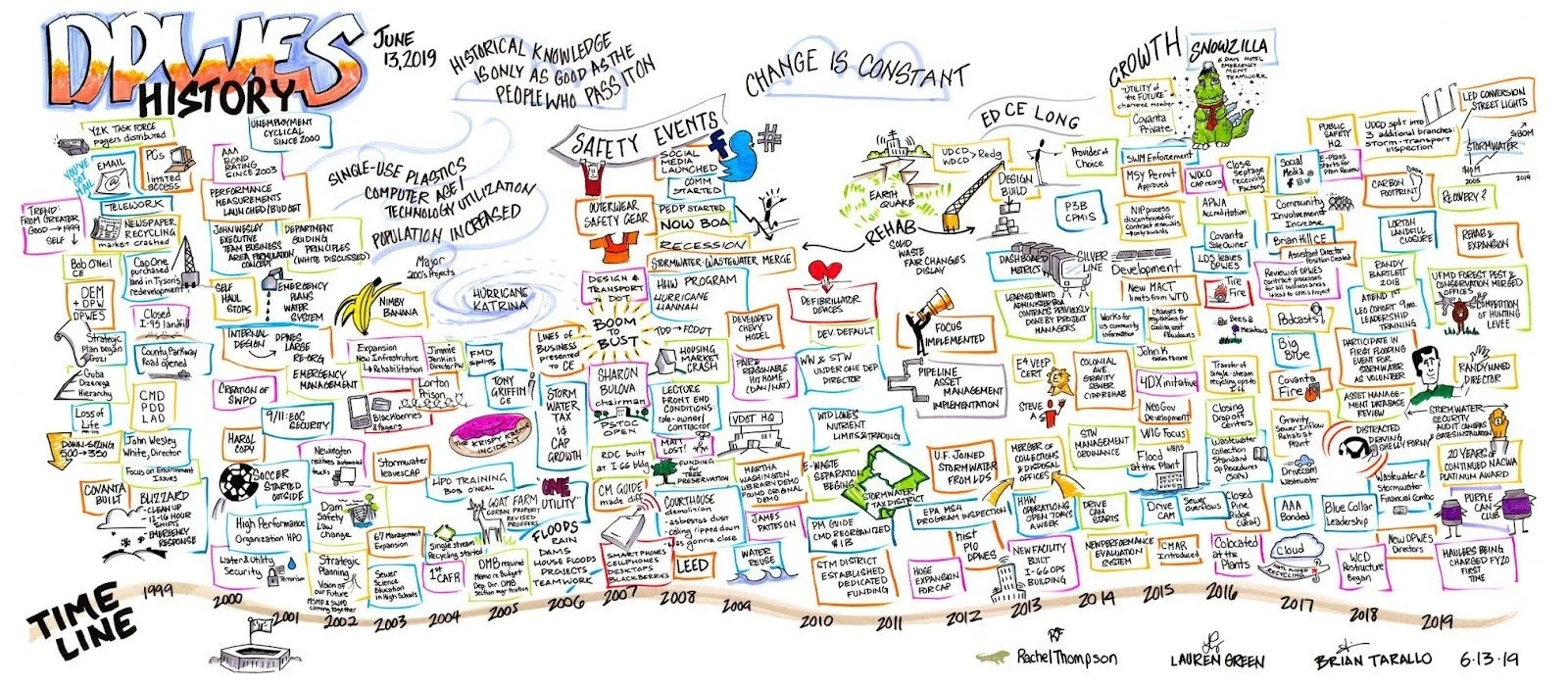The Power of Graphic Histories in Organizations
Organizations don’t just “exist.” They’re living systems shaped by milestones, turning points, and the people who show up along the way. The problem? That history usually lives in half-remembered stories, scattered files, or not at all. Enter Lizard Brain.
A Graphic History is a way to change that. It’s a structured, visual process for pulling those pieces together into one big, shared story. By mapping events, patterns, and lessons learned on a single, large-scale timeline, teams can see their journey clearly, strengthen collective memory, and uncover insights that inform what comes next.
This paper lays out the purpose, process, and value of using Graphic Histories as a facilitation tool for teams and organizations.
1. Why Use a Graphic History?
A Graphic History helps groups literally see their story. It’s a collaborative, visual format that captures the memory of an organization, project, or initiative in a way words alone can’t. Its goals:
Understand the journey. Show how the organization has evolved, adapted, and overcome challenges.
Harvest lessons. Pull forward what worked, what didn’t, and what’s worth carrying into the future.
Build shared memory. Give everyone—old guard and new hires alike—a common reference point.
Strengthen team cohesion. Spark storytelling, dialogue, and appreciation for what’s been built together.
Create context for planning. Connect the dots between past experiences and today’s big decisions.
2. How the Graphic History Process Works
A typical Graphic History session runs one to three hours. It’s structured enough to stay on track but flexible enough to let the storytelling flow:
Step 1: Set the stage.
We start by explaining what’s ahead: purpose, agenda, ground rules. The visual we build is a draft—judgment-free and collaborative.
Step 2: Build the frame.
We lay out the timeline: time runs horizontally, categories (people, events, initiatives, milestones) stack vertically. Visual cues, like icons, lines, and symbols, keep it clear.
Step 3: Tell the story.
Participants share origins, key moments, and big shifts. The facilitator listens, distills, and captures these live on the timeline.
Step 4: Spot turning points.
We highlight highs, lows, and inflection points, often uncovering patterns no one saw until they were mapped out.
Step 5: Surface insights.We reflect: What worked? What didn’t? What are we still carrying forward (for better or worse)?
Step 6: Name the eras.
Groups give names to distinct phases: short, memorable labels that capture the essence of each chapter.
Step 7: Close and carry forward.
We wrap by reflecting on new insights, acknowledging contributions, and discussing how this history informs what’s next. Teams often leave with a digital or printed version to keep the story alive.
3. The Value It Brings
A Graphic History pays off in multiple ways:
Shared narrative. Everyone gets on the same page about how we got here.
Better decisions. Past lessons prevent repeated mistakes and sharpen strategy.
Stronger culture. Storytelling builds trust, recognition, and connection.
Faster onboarding. New team members get the context they need in one visual snapshot.
Celebration and recognition. Successes and milestones are named and honored.
Strategy fuel. It creates a launchpad for visioning and long-range planning.
A Graphic History isn’t just a pretty timeline. It’s a collective sense-making tool. It captures the heartbeat of where you’ve been and turns it into a foundation for where you’re going. Whether you’re closing a project, marking an anniversary, or kicking off strategic planning, a Graphic History helps teams honor their past while plotting the next chapter together.
To find out how a Graphic History can benefit your organization, email us at hello@lizardbrain.com, or schedule a discovery call by clicking here:
https://calendly.com/brian-lizardbrain/45-min-discovery-call








